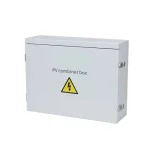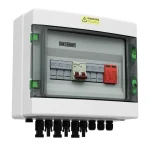Designing a high-efficiency solar power system begins with choosing the right inverter and PV combiner box. But with so many technical parameters, how can you be sure you’re making the right decision?
In this article, we walk you through a real-world case—144 solar panels of 555W each paired with a powerful 80kW inverter—and demonstrate exactly how to calculate your system’s configuration. You’ll learn how to match string configurations, assign MPPTs, and size your combiner box with confidence.
What Does a PV Combiner Box Do?
Before jumping into the calculations, let’s review the role of a combiner box. A PV combiner box connects multiple strings of solar panels in parallel. It collects DC output from each string and routes it through a common bus to the inverter. This box typically includes:
String fuses or breakers
Surge protection devices (SPD)
DC disconnect switches
Monitoring units (optional)
Choosing the correct number of inputs (strings) and output (combined) requires understanding your system’s design and electrical parameters.
Project Overview: 144 pcs 555W Solar Panels + 80kW Inverter
Let’s analyze the real system configuration:
Here is the specific parameters of solar panels.
Here is the specific parameters of solar inverter.
Step 1: Calculate Total System Power
Total modules = 144
Power per module = 555W
Total system power = 144 × 555 = 79,920W
✅ This is within the inverter’s rated max PV input of 80,000W.
Step 2: Determine Number of Strings (Series + Parallel)
A. Decide How Many Panels per String
We need to make sure the Voc of each string does not exceed 1000V (the inverter’s max DC voltage).
Voc per panel = 49.95V
Max panels per string = 1000V ÷ 49.95V ≈ 20 panels
We also want the Vmp to fall within the inverter’s MPPT range (150–850V):
Vmp per panel = 42.10V
Vmp for 20 panels = 20 × 42.10 = 842V ✅ within range
So, 20 panels per string is suitable.
B. How Many Strings in Total?
Total panels = 144
Panels per string = 20
Total strings = 144 ÷ 20 = 7.2 → round down to 7 full strings
But 7 strings × 20 panels = 140 panels, leaving 4 unused panels. These can either be:
Reserved as spare stock
Added to an 8th string (if inverter can handle it)
➡️ For a neat configuration, use 8 strings (7 of 20 panels, 1 of 4 panels — only if inverter supports different string lengths on same MPPT)
But typically, we use full strings only. So we recommend:
✔️ 7 strings of 20 panels = 140 panels used
Step 3: Assign Strings to MPPTs
Inverter has 4 MPPTs, each handling 2 strings. That’s 4 MPPTs × 2 = 8 input channels.
You can configure:
MPPT1: 2 strings
MPPT2: 2 strings
MPPT3: 2 strings
MPPT4: 1 string
⚠️ One channel will be left unused, or the 8th string of 4 panels can be added if voltage/current match.
Step 4: Check Current Limits
Isc per panel = 14.04A
Each string (in series): current remains the same → 14.04A
Each MPPT: 2 strings in parallel → 14.04A × 2 = 28.08A
✔️ Inverter’s max per MPPT input current = 36A → safe.
Step 5: Select the Right PV Combiner Box
You need to merge multiple input strings into a single output to feed the inverter cleanly and safely.
Option A: One Large Combiner Box
7 inputs, 1 output
Pros: compact, centralized wiring
Cons: longer DC cables if strings are far apart
Option B: Multiple Small Combiner Boxes (e.g., two 4-in-1 boxes)
Installed closer to each string group
Pros: shorter string cable runs, easier installation
Cons: slightly higher cost, more boxes to manage
✅ Recommendation: Use two 4-in-1 combiner boxes for better modular layout and easier maintenance.
Step 6: Voltage and Output Specs for Combiner Box
Max input voltage = 1000V DC
Output = 1 circuit per box
Rated current per input = ≥15A
Output breaker rated for ≥30A
⚠️ Always choose combiner boxes with voltage rating equal to or higher than your string’s Voc × 1.25 safety factor.
→ 49.95V × 20 × 1.25 = 1248.75V, but 1000V is your inverter limit, so use 1000V-rated components.
Case Summary
In this example, we successfully designed a 144-panel solar system using a high-performance 80kW inverter with 4 MPPT inputs. Each MPPT input was assigned 2 strings, with 18 modules in each string. The voltage and current calculations were carefully done to ensure full compatibility and safe operation.
The system was paired with four DLCB series 2-in-1-out PV combiner boxes, each handling one MPPT input. This setup ensures:
Optimal power tracking across all strings
Safer current distribution
Easy future maintenance
Clean and reliable wiring layout
Introducing Derlicn DLCB Series PV Combiner Boxes
To maximize safety and performance, Derlicn’s DLCB series combiner boxes are engineered for precision and protection in modern solar installations.
Key Features:
Flexible Input Configuration: Available in 2-in-1-out, 4-in-1-out, 6-in-1-out, up to 24-in-1-out.
Wide Voltage Support: DC 600V, 1000V, and 1500V options.
Full Protection Suite: Includes DC fuses, surge protection devices (SPD), and circuit breakers.
Sturdy Build Options: Choose between metal enclosures for enhanced durability or plastic (PC/ABS) shells for lightweight installations.
IP65 Weatherproof Rating: Designed for both rooftop and ground-mounted systems.
Clear Labeling & Pre-wired: Easy to install, inspect, and maintain.
Whether you’re working with residential rooftops, commercial walls, or utility-scale solar farms, our DLCB series ensures a safe, clean, and efficient system layout.

Metal Enclosures PV Combiner Box

Plastic Enclosures PV Combiner Box
Need Help Choosing the Right Combiner Box?
Designing the right PV system requires more than just picking parts. It involves precise electrical calculations, layout optimization, and safety planning. That’s why our engineers are here to help.
📩 Contact Derlicn today with your project specs — and we’ll provide tailored system selection and wiring diagrams to make your installation worry-free.
Table of Contents
Have you Any Questions?
Can’t find an answer to your question, or want more information about our products? If so, please feel free to get in touch with our professional team. We’re here to help you drive your projects to success.
